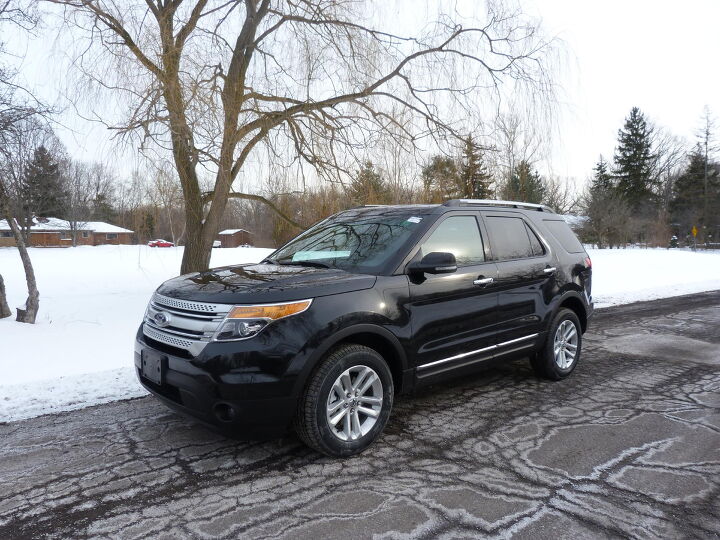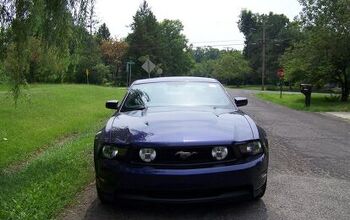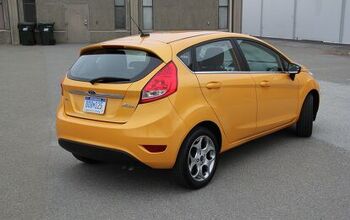Review: 2011 Ford Explorer Take Two
I thought the Ford Freestyle would sell well because it was so incredibly functional. It didn’t, even if I bought one myself (in updated Taurus X form). I thought the Ford Flex would sell well because it combined even more room and comfort (if inferior visibility) with the style of a MINI. It hasn’t done well, either. But Ford hasn’t given up. For the 2011 model year the Explorer, which ruled the SUV segment through the 1990s, has been transferred to the Volvo-derived platform that provided the basis for both the Freestyle and the Flex. Why might its fate be different?
In a word: styling.
The Freestyle looked like a large wagon. Wagons, as much as driving enthusiasts love them, fell out of public favor about a quarter-century ago. The Freestyle, along with its Five Hundred sedan counterpart, also demonstrated that too few Americans were interested in Fords that looked like supersized B5 Passats. Bauhaus has never possessed broad appeal on this side of the Atlantic.
So the Flex went in a very different direction, making a much stronger design statement that, despite some British influences, was clearly American. This statement connected strongly with some people but repulsed far more. It didn’t help that the Flex retained the proportions of a station wagon.
In contrast, the new Explorer is proportioned like an SUV. Compared to the Freestyle, it’s three inches less lengthy (197.1), four inches wider (78.9), and a couple inches taller (70.4). The hood and beltline have shifted skyward even more than the roofline. Between these proportions and clean-but-bold styling, the new Explorer looks athletic and even tough in a way the Freestyle and Flex never have. There’s something different here, especially in the shape of the nose, so the new Explorer won’t get lost in a sea of crossovers. But it’s not so different that people will be scared away. After two failures that went against industry trends, Ford has given the market the exterior styling it wants in a crossover.
The new Explorer’s interior is dominated by the new MyFord Touch system, which includes a pair of a small LCD displays flanking an analog speedometer and a large touchscreen in the center stack. This system has come under fire for difficulty of use, but aesthetically it makes the interiors of the Freestyle, Flex, and every competitor appear dated. The base audio system includes raised touch-sensitive controls on matte black plastic. The optional Sony audio system substitutes a totally smooth glossy black panel. Use the sophisticated voice controls (which do involve a learning curve of their own) and the hard-to-use non-buttons can largely be avoided.
Aside from these controls, the styling of the new Explorer’s interior is more conventional than that of the Flex. Materials are above average for the class, if not luxurious. Soft polymers cover the instrument panel and doors. And yet the door panels still appear cheap, courtesy of “stitching” that is far-too-obviously fake. Because with more convincing faux upholstery it’d be a Lincoln? GM included similar stitching in the 2007 Saturn AURA, only to remove it a year later following intense criticism. Apparently GM’s lesson wasn’t learned in Dearborn.
Climb into the driver’s seat and the dramatic changes continue. The wider body translates into three additional inches of shoulder room, for a noticeably beamier cabin. The instrument and door panels seem massive. I generally set the driver’s seat in its lowest position, but felt compelled to raise that in the new Explorer. There’s plenty of headroom in which to do this—I could have worn a top hat. Even with the seat raised visibility takes a hit—the A-pillars are massive and the others are also fairly wide. The cloth seats are overly mushy (can a seat be appropriately mushy?); for long-distance comfort the firmer leather buckets should be better, if still not as good as the thrones in the Flex.
Like in the Freestyle and Flex the second row is a comfortable height off the floor. But, despite what the spec sheet suggests, there’s less second-row legroom than in the Freestyle much less the limo-like Flex. There’s enough room for adults, but not enough for them to stretch out. It helps that there’s plenty of room for even boot-clad feet beneath the front buckets. But it’s necessary to fold the headrests before folding the second-row seats—otherwise they hit the front seats. (The second-row headrests in the new Dodge Durango must also fold, but do so automatically when the seat is folded.) Dimensions in the third row are similar to those in the Freestyle and Flex, so two adults will fit knees-high in a pinch.
When the third row is upright there’s a deep well behind it, an advantage over many crossovers. The innovative system for folding the third-row seats to form a low, flat floor carries over from the Freestyle and Flex. It’s so easy to operate that the optional power-folding third-row would not remotely be worth its additional cost and complexity even if it weren’t much slower. Despite the wider body, the Explorer’s cargo area isn’t significantly wider than the Freestyle’s. The additional inches appear to have disappeared into the sidewalls. Factor in the truncated rear overhang, and there’s a little less total cargo volume than in the Freestyle. But the difference wouldn’t be significant except for one other change: unlike those in the Freestyle and Flex, the new Explorer’s front passenger seat does not fold. So you won’t be transporting a kayak (or very long ladder) inside the car. This potential—which I might never actually use—is one of the things that initially attracted me to the Freestyle. Being able to fold every seat save the driver’s to form a very long, totally flat load floor is a thing of beauty to some of us.
Outfitting the Freestyle for soft-roading apparently involves adding a lot of pounds. The all-wheel-drive Explorer tips the scales at 4,750, an increase of over 500 compared to the Taurus X (essentially a Freestyle with a 3.5-liter V6 and conventional automatic). The 3.5-liter V6 from the Freestyle and Flex has been tweaked to bump peak horsepower by 27, to 290, at 6,500 rpm. Mid-range power (as indicated by peak torque) receives much less of a bump. Given the curb weight increase, acceleration is more leisurely than in the Freestsyle, but still easily quick enough for the way the Explorer asks to be driven. (There’s not a whiff of sports car here.) As in other applications, the Ford 3.5-liter V6 sounds a little gruff and pedestrian when revved. The six-speed automatic carries over, but unlike in the Freestyle and unboosted Flex it can be manually shifted, via a toggle on the shifter. This feature isn’t only useful in sports cars. I badly missed the ability to hold the transmission in a specific intermediate gear while traversing muntainous West Virginia in my Taurus X this past weekend.
Those seeking more power are out of luck, at least in the near term. Ford’s twin-turbocharged V6 won’t be offered, at least not this year. Instead, a turbocharged four will be available with front-wheel-drive. The turbo four is considerably less powerful than the V6 (237 HP), but about equally torquey. Will Americans be willing to spend an extra $1,000 for two-to-three more MPG? Despite its additional mass, even with the V6 the Explorer is more fuel efficient than the Freestyle with a 3.5 (a.k.a. the Taurus X). I get 16.5 around town in my Taurus X. In the Explorer the trip computer reported 18.5 in similar driving. The EPA ratings back this up: 15/22 in the Taurus X AWD, they’re a more competitive 17/23 in the Explorer AWD. Whatever enables the much heavier Explorer to get better fuel economy…I want it in my car.
The suspension tuning is firmer than in the Flex, but not as firm as in the Freestyle. Given the size, weight, and mainstream mission of the new Explorer, it handles well, if not sportily. The steering provides little feedback, but it’s nicely weighted and quick. When hustled, the new crossover feels a half-size smaller and lighter than it actually is—bearing in mind that it’s tall, wide, and heavy and the driving position will never let you forget this. The Explorer likes to rotate, and so feels more agile than the Flex (such things being relative) if decidedly less car-like than the Freestyle. Body motions are somehow better-controlled than in the lower, more firmly sprung Freestyle, and both understeer and lean in hard turns are moderate. The proactive stability control (“curve control” in Ford-speak) operates transparently most of the time. The ride is usually smooth and very quiet. At idle the engine is nearly silent.
Crossovers happened because people will pay substantially more for them than for a wagon or a minivan. I drove a fairly low-end 2011 Explorer, an all-wheel-drive XLT with Package 201A (MyFord Touch, rearview camera, dual automatic HVAC), Towing Package, and floormats. The list price: $36,645. It’s possible to option an Explorer well over $40,000. A similarly-equipped 2009 Ford Taurus X listed for about $4,000 less. Adjusting for the Explorer’s additional features using TrueDelta’s car price comparison tool cuts the difference to about $1,500, which seems very reasonable. But Ford had rebates of up to $4,000 on the Taurus X, vs. $1,000 currently on the new Explorer. So in terms of transaction prices the increase is considerable. Looking at current competitors, a comparably equipped new Dodge Durango tends to be a few hundred dollars less than the new Explorer.
I was especially eager to drive the new 2011 Ford Explorer because I recently bought a 2008 Taurus X. Will I later want to swap to the new vehicle? Now that I’ve been able to compare the two, I’m not feeling the urge. The Explorer’s styling definitely has broader appeal. And the MyFord Touch looks great and is fun to play with even if it’s not always easy to use. But while smooth, quiet, and composed the Explorer drives less like a car. It’s also harder to see out of, has less legroom in the second row, and its front passenger seat doesn’t fold. In other words, functionality didn’t sell, so it wasn’t nearly as high a priority this time around. Nevertheless, I expect the new Explorer to sell much better than the Freestyle, Taurus X, or Flex ever did. Will I be wrong once again? Probably not. My personal priorities aren’t widely shared. Conventionally attractive styling does sell and the new Explorer looks the part while doing everything else well enough or better.
Frank Cianciolo, an excellent salesperson at Avis Ford in Southfield, MI, provided the car for this review. Frank can be reached at 248-226-2555.
Michael Karesh operates TrueDelta, an online source of automotive pricing and reliability data.
Check Jack Baruth’s take on the 2011 Explorer here.
Michael Karesh lives in West Bloomfield, Michigan, with his wife and three children. In 2003 he received a Ph.D. from the University of Chicago. While in Chicago he worked at the National Opinion Research Center, a leader in the field of survey research. For his doctoral thesis, he spent a year-and-a-half inside an automaker studying how and how well it understood consumers when developing new products. While pursuing the degree he taught consumer behavior and product development at Oakland University. Since 1999, he has contributed auto reviews to Epinions, where he is currently one of two people in charge of the autos section. Since earning the degree he has continued to care for his children (school, gymnastics, tae-kwan-do...) and write reviews for Epinions and, more recently, The Truth About Cars while developing TrueDelta, a vehicle reliability and price comparison site.
More by Michael Karesh
Latest Car Reviews
Read moreLatest Product Reviews
Read moreRecent Comments
- Akear The front reminds me of the Pontiac Aztec, though it does look better than that infamous vehicle. I predict they will sell about 5,000 of these annually.
- Chris Teague I'm putting the Pilot Sport 4s back on my GR Corolla next week, so all of New England can thank me for the late spring snow storm we'll undoubtedly have right after that.
- 285exp I am no less interested in buying an EV this year as I was last.
- FreedMike @Tim Healey: Off topic but this site is becoming borderline unusable from a technical standpoint, and it doesn't matter if I'm using my phone, laptop or Ipad. At some point you can't type anymore.
- Rochester It depends entirely on the vehicle. Summer-only tires are pointless on a Sentra, but awesome on a Z.



















































Comments
Join the conversation
Hi Michael, thanks for the review. I'm curious as to which test vehicle you preferred overall -- the JGC or this Explorer, and why?
just rented a 2012. It quit, smooth but the minute it hits a bump the ride is harsh. its like there 60psi in the tires. It goes back to National in the morning. I rent the big GM's and I'm an MDX owner both have their own excellent characteristics in ride/handling without a show stopper like the Explorer's bumpy ride